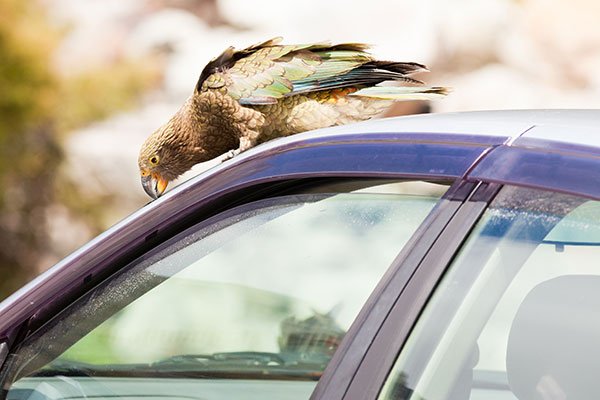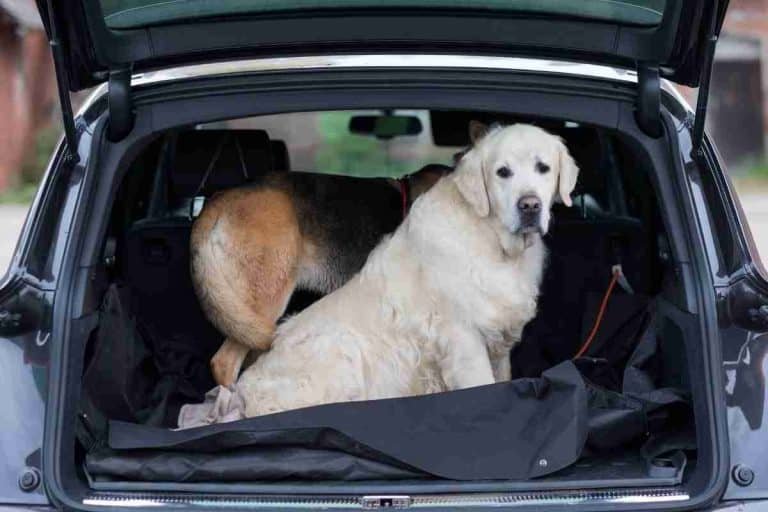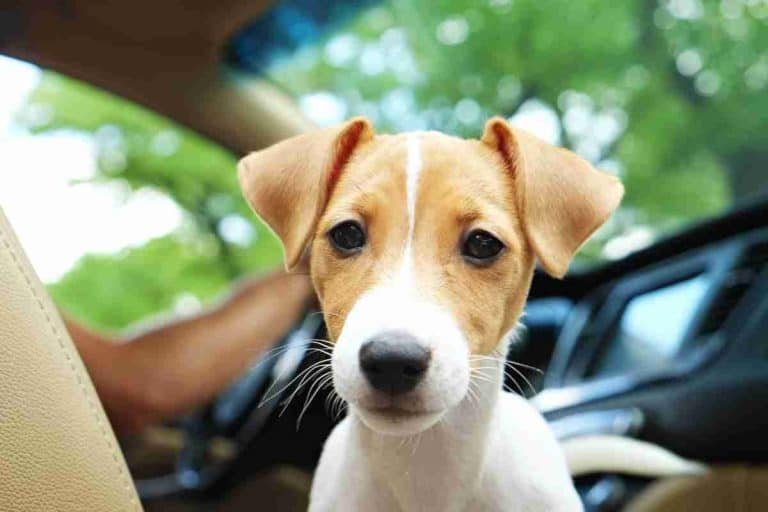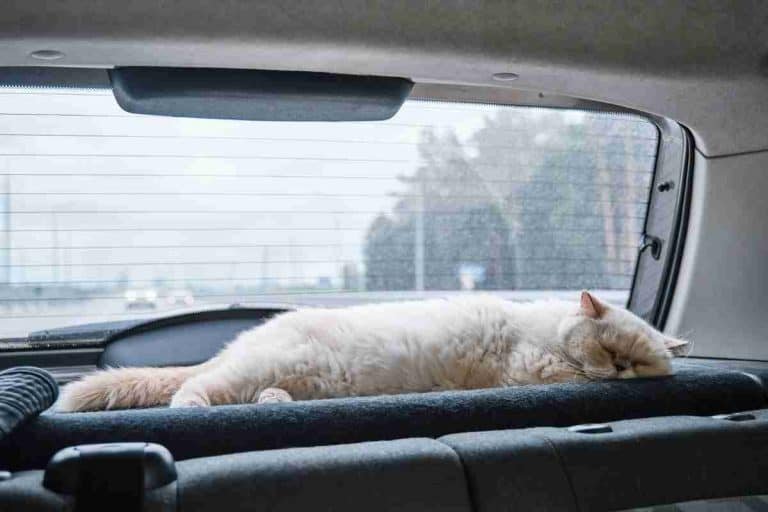How to Safely Travel by Car on Vacation with Your Parrot
Affiliate Disclaimer: As an affiliate, we may earn a small commission when you make a purchase from any of the links on this page at no additional cost to you!
Last Updated on October 18, 2025
Traveling by car on vacation with a parrot can be safe and manageable. How to Safely Travel by Car on Vacation with Your Parrot starts with health screening and training. The right setup matters. Success includes an avian vet check, acclimation sessions, and a stable, well‑ventilated travel carrier secured against sudden stops. Thoughtful route planning, steady cabin temperatures, and regular hydration breaks reduce stress, motion sickness, and overheating.
The guide provides readiness checklists, carrier selection and fastening, step‑by‑step training, and emergency planning. It also covers temperature control, rest stops, harness safety, and post‑trip recovery. These practices help owners avoid common risks and keep every mile safer for their companion bird.
Can I travel by car on vacation with my parrot?
Yes—traveling by car on vacation with a parrot is possible when the owner follows careful preparation and risk management. How to Safely Travel by Car on Vacation with Your Parrot starts with evaluating the bird’s health, temperament, and the trip’s pace. Short drives with frequent stops suit many parrots. Long, nonstop legs stress some species and increase dehydration and overheating risk.
Owners should choose a stable, appropriately sized carrier and position it where road vibration is lowest. Covering the carrier partially reduces visual stress while allowing airflow. Maintain cabin temperature between 65–80°F and avoid direct sun. Offer water during regular stops and secure any loose items that could fall into the bird’s space during sudden braking.
Plan routes with avian-friendly vet clinics and pet emergency contacts along the way. For general road-trip logistics and essential gear ideas, consult Essential dog travel tips and gear for road trips. Owners should document the parrot’s normal behaviors before departure; that baseline helps detect travel-related distress quickly.
Quick readiness checklist (health, behavior, carrier comfort)
Use this concise checklist the week before departure. It helps confirm the parrot can handle a car vacation safely.
- Vet clearance: Schedule a pre-trip exam within two weeks. Confirm vaccinations, parasite control, and fitness for travel.
- Behavioral readiness: Ensure the parrot accepts the carrier, allows gentle handling, and tolerates short drives without severe vocalization or panic.
- Carrier comfort: Choose a carrier with room to perch and turn. Secure perches and a non‑spill water dish. Line the floor with absorbent material.
- Acclimation training: Practice incremental trips—5, 15, then 30 minutes—rewarding calm behavior.
- Food and hydration plan: Feed a light meal 2–3 hours before departure. Offer water at stops. Pack familiar food and measured portions.
- Safety gear: Bring an emergency kit, travel harnesses if used, and a carrier restraint or secure placement method. For tips on securing carriers, see how to secure a cat carrier in car.
CTA: If any checklist item fails, postpone travel and consult the veterinarian.
When to leave your bird home (illness, heavy molt, extreme weather, lack of training)
Some conditions make travel unsafe. Owners must choose boarding or a trusted sitter when risks exceed benefits.
- Illness or recent medication: Do not travel if the parrot shows respiratory symptoms, low appetite, eye discharge, or is recovering from surgery. Transport can worsen illness.
- Heavy molt or injury: Heavy molt increases stress and the chance of hemorrhage. Injured birds need stability and quiet, so skip travel until healed.
- Extreme weather: Avoid trips during heat waves, severe cold, or storms. Birds tolerate narrower temperature ranges than humans.
- Lack of training or severe anxiety: If repeated short drives provoke panic, do not force a long trip. Prolonged stress suppresses immunity and triggers self-mutilation in some parrots.
When in doubt, contact the avian veterinarian. For strategies to address travel anxiety before deciding, owners can review approaches like those in 9 natural ways to remedy your dog’s travel anxiety. Choosing to leave the bird home can protect its health and prevent traumatic experiences during vacation travel.
How travel affects parrots — stress, sickness and body language
Car travel exposes parrots to unusual motion, sounds and smells. Those factors can trigger acute stress responses and upset the vestibular system. Stress often shows first as subtle body-language changes before sickness appears. Watch posture, breathing and feather condition closely.
Parrots under stress may pin their eyes, fluff or press their body low on a perch. Appetite can drop and droppings may change in color or consistency. Prolonged travel stress can lead to feather-plucking, chronic weight loss or immune suppression. Temperature swings inside a vehicle can worsen respiratory issues.
Practical steps reduce risk. Start short acclimation drives so the bird learns the sound and motion of the car. Use a secure, well-ventilated travel cage or carrier fitted to prevent sliding. Provide a stable perch or non-slip surface rather than letting the bird stand on the cage floor. Cover the carrier partially to reduce visual stimuli but leave enough light to read body language.
Keep the cabin quiet, control air flow and avoid strong perfumes or air fresheners. As mentioned earlier, regular breaks for water and quick checks help. Consult an avian veterinarian before a long trip for a health check and tailored advice. For more general tips on calming small pets in cars see How to calm down a cat in the car.
Common travel stress signals to watch
Recognizing signs early prevents escalation. Look for these common signals during a drive:
- Vocal changes: High-pitched screeching, nonstop calling or sudden silence can both indicate stress.
- Eye pinning and beak clacking: Rapid pupil changes or aggressive beak behavior often precede a bite.
- Fluffed feathers or hunching: The bird attempts to conserve energy or signals discomfort.
- Panting or open-mouth breathing: A red flag for overheating, fear or respiratory distress.
- Regurgitation or diarrhea: Acute stress can trigger digestive upset.
If any of these signs appear, the immediate response matters. Pull over safely and offer quiet reassurance. Avoid forced handling unless necessary; a covered carrier calms many birds. Offer water and observe droppings for abnormal color or consistency. If symptoms persist or worsen, seek veterinary care promptly.
Car distress in other pets shows parallels; for comparison, see Why do dogs cry in the car? Pack a small avian first-aid kit and the bird’s medical records before departure.
Causes and prevention of motion sickness in birds
Motion sickness arises from a conflict between visual cues and vestibular input. Rapid turns, constant acceleration or jerky driving amplifies that conflict. Anxiety and unfamiliar smells or motion make symptoms worse. Young birds and those new to travel show higher susceptibility.
Prevention focuses on reducing sensory mismatch and building tolerance. Start with several five- to ten-minute drives, increasing length only if the bird stays calm. Secure the carrier so it faces forward and stays stable; a low center of gravity reduces vestibular stress. Provide a steady perch at a comfortable height so the bird sees the horizon when possible.
Offer a light snack an hour before travel to avoid both an empty and an overly full crop. Maintain cool, consistent airflow and avoid sudden stops or fast acceleration. Never use over-the-counter human anti-nausea drugs without veterinary approval. An avian vet can recommend safe antiemetics or short-term anxiety-relief strategies when needed.
For additional motion-sickness prevention techniques used with dogs, which often translate to birds, see No more doggie dramas: how to make car rides enjoyable for your motion sick pup. Schedule a vet consult before the vacation to review hydration, medication options and a stepwise acclimation plan.
Selecting and securing the right travel setup
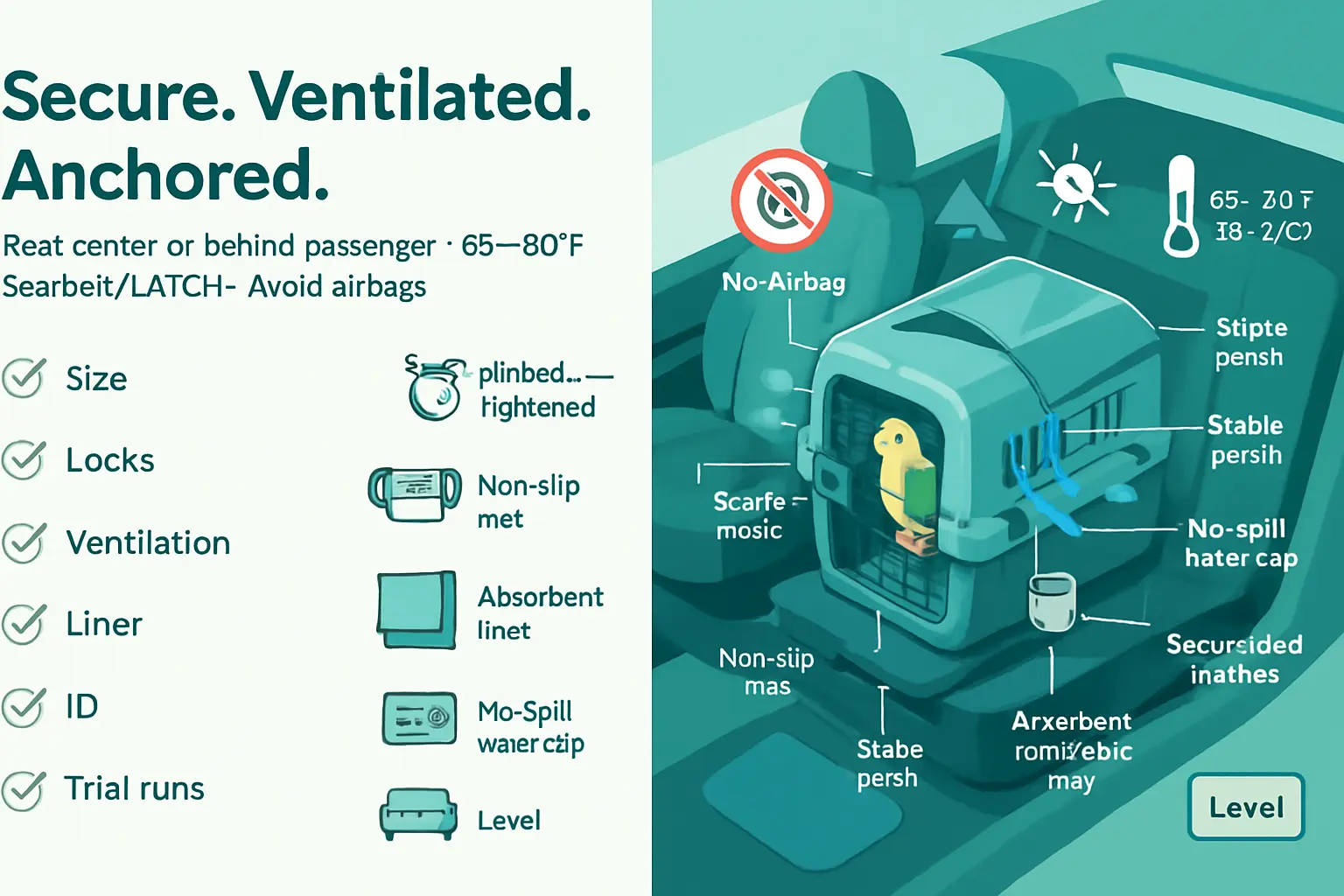
How to Safely Travel by Car on Vacation with Your Parrot starts with choosing equipment that keeps the bird calm and protected. Prioritize a travel solution sized for the parrot’s wingspan and perch height. The setup should resist tipping, allow airflow, and let the bird adopt a natural posture. Test the carrier or cage in short drives before a long trip to confirm comfort and behavior.
Plan for temperature control, shade, and a secure feeding area. Use absorbent liners and easy-to-clean trays. Label the carrier with contact details and medical notes. Bring a familiar toy and a small perch to reduce stress. For broader packing and gear ideas that apply to road trips, consult essential dog travel tips and gear for road trips.
Quick checklist: correct size, sturdy locks, good ventilation, washable lining, ID label, trial runs. Schedule a pre-trip veterinary check if the parrot has health concerns.
What to look for in a travel carrier or travel cage
A parrot’s carrier must combine protection, comfort, and visibility. Choose a design with solid construction and smooth edges. Bar spacing should prevent wing or beak entrapment. The carrier should allow the bird to stand on its toes without touching the top.
Look for these features:
- Secure, tamper-proof latches and a secondary lock.
- Good ventilation on multiple sides but no direct drafts.
- Stable perches or removable soft perches to prevent foot strain.
- Leak-proof, removable tray for quick cleaning.
- Lightweight but crash-resistant materials.
Soft-sided carriers suit short rides only. For extended travel, a rigid travel cage or airline-style travel cage gives better protection. Train the parrot to accept the carrier gradually. Reward calm entries and short stays. For comparison ideas on travel crates and safety features, see best dog crates for car travel in 2023.
Carrier placement and fastening inside the car
Placement and secure fastening absorb motion and protect the parrot. Place the carrier on the vehicle’s floor behind the front passenger seat or in the rear center seat. These positions minimize lateral movement and reduce crash risk. Never place a carrier in front of an active airbag.
Secure the carrier with the seatbelt routed through or around it. Use seat anchors, LATCH straps, or heavy-duty bungee cords to limit forward and sideways travel. Add a non-slip mat beneath the carrier to stop sliding. Check straps at each stop; vibration can loosen knots.
Keep the carrier level. Tilt causes the bird to lose footing and increases stress. Provide shade to avoid direct sun and monitor cabin temperature closely. For step-by-step fastening tips used for small animal carriers, review how to secure a cat carrier in car.
Pros and cons of bird car seats versus harness use
Bird car seats and harnesses offer different trade-offs in safety and convenience. A purpose-built bird car seat gives a contained perch area and often secures with the vehicle belt. It reduces movement and keeps the bird visible. However, many car seats lack standardized crash testing for birds.
Harnesses let a parrot perch on the owner or seat. They allow interaction and reduce confinement stress for some birds. But harnesses risk escape during stops and place the bird in the cabin zone during a crash. Improperly secured harnesses can cause severe injury.
Recommendations:
- For safety, prefer a secured carrier or travel cage for long trips.
- Use a harness only for supervised short stops, never during highway travel.
- Choose harness designs tested for avian use and anchor them to a seatbelt point.
Before using a harness or car seat, consult an avian veterinarian about fit and safety. For notes on securing pets in vehicles, see how to secure a dog in car with leash. Consider a professional fitting or practice sessions to confirm the parrot tolerates the option.
Training and acclimation before you go
Gradual training and acclimation reduce travel stress and improve safety when traveling by car with a parrot. Start weeks before departure. Confirm the bird is healthy, up to date on vaccinations, and cleared by a veterinarian for travel. Establish a predictable routine of feeding, handling, and quiet time so the parrot associates travel with familiar rhythms.
Focus goals on three areas: carrier tolerance, motion tolerance, and calm response to car sounds. Schedule short, repeated sessions rather than rare long ones. Use low-level audio of road noise and engine vibration near the cage to desensitize the bird. Offer favorite treats and toys only during training sessions to create positive associations.
Choose a carrier with solid ventilation, secure latches, and enough space to perch comfortably. Plan where the carrier will ride in the vehicle and practice securing it there. For guidance on reducing motion-related reactions, review tips for motion-sick pets like how to make car rides enjoyable for your motion-sick pup. Build sessions progressively and track the bird’s stress signals each day.
Step-by-step carrier habituation plan
Phase 1 — Familiarization (days 1–4): Place the carrier in the home where the parrot spends time. Leave the door open and add familiar perches, bedding, and toys. Feed meals partially inside the carrier. Keep sessions short and rewarding.
Phase 2 — Short enclosures (days 5–10): Encourage voluntary full entries by hiding high-value treats at the rear. Close the door for one to three minutes while the bird remains calm, then reopen and reward. Lengthen closure gradually.
Phase 3 — Stationary car practice (days 11–14): Secure the carrier in the parked car. Sit nearby and offer treats. Turn the engine on for a minute, then off. Increase engine time slowly while watching for panting, droppings, or wide-eyed vigilance.
Phase 4 — Short drives (weeks 3–4): Start with 5–10 minute drives on smooth roads. Keep cabin temperature stable and avoid loud music. After each drive, offer a calm reward and note behavioral changes. Secure the carrier using proven methods; see tips on securing pet carriers like how to secure a cat carrier in car. Stop or slow progression if stress signs increase.
Basic harness training and safe practice sessions
Select a well-fitted bird harness designed for parrots. The harness should allow natural wing movement while preventing escape. Measure carefully and choose a harness that distributes pressure across the chest and back.
Start indoors with the harness draped over clothing. Reward calm behavior. Next, put the harness on for one to two minutes, then remove and reward. Increase wear time daily to 10–15 minutes, then to 30 minutes. Use clicker or target training to encourage perching and stepping into the harness.
Practice leash handling in a quiet room. Teach the parrot to step up onto a hand or perch while wearing the harness. Progress to supervised outdoor sessions or short walks in a secure area. For car trials, attach the leash to a fixed anchor while the bird sits on the carrier or a seat perch. Avoid tying the leash to moving parts.
Keep sessions brief and end on a calm note. If the bird shows persistent agitation, pause training and consult an avian behaviorist or veterinarian. Regular, positive practice builds reliable harness tolerance and safer vacation travel. For securing pets in vehicles with a leash or tether, review guidelines like how to secure a dog in car with leash.
Planning the route: trip length, stops and temperature control
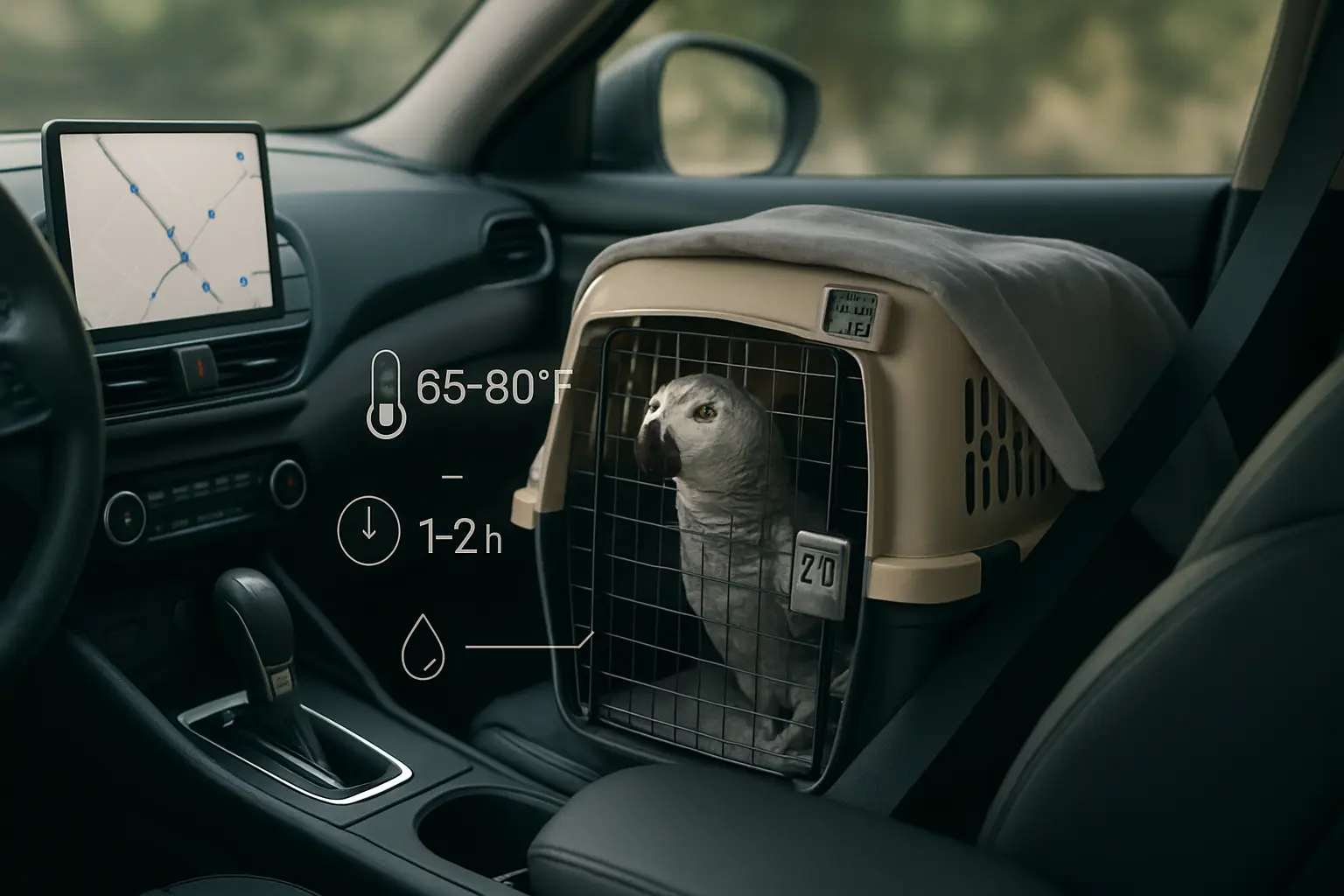
How to Safely Travel by Car on Vacation with Your Parrot starts with route planning that prioritizes the bird’s comfort and safety. Map realistic daily driving goals based on the parrot’s age, health and prior travel experience. Limit driving time, schedule regular stops and plan overnight stays in pet-friendly lodging with climate control.
Factor in seasonal temperature changes along the route and the time of day for peak heat or cold. Build buffer time for delays and extra rest breaks. Choose roads with safe pullouts and pet-friendly parks for supervised time. Prepare alternative plans if a planned stop becomes unsuitable.
As a practical resource for general pet road-trip gear and checklists, see Essential dog travel tips and gear for road trips. Before leaving, confirm veterinary records, pack a travel first-aid kit and notify lodging about an avian guest. For safety: consult a vet about medications or calming strategies and carry the vet’s contact details.
Recommended trip durations and how to increase distance safely
Start with short hops and increase distance gradually. For most parrots, begin with 10–20 minute drives at home. After successful short trips, extend to 45–60 minutes, then to two-hour legs. Gauge tolerance by observing breathing, vocalizations and behavior at the end of each trip.
Use a secure travel cage or carrier sized for the parrot to perch comfortably. Condition the parrot to the carrier indoors before travel. When increasing distance, keep routine feeding and sleep schedules consistent to reduce stress.
If crate selection or securing methods need review, consult a resource like Best dog crates for car travel for ideas about sturdy carriers and vehicle anchoring. Do not push a bird through long drives after distress signs. If the parrot shows persistent panting, fluffed feathers, or lethargy, stop and consult a vet.
How to plan and manage rest stops (hydration, stretching, supervised time)
Plan stops every 1–2 hours for hydration and supervised activity. At each stop, offer fresh water and a small snack if it’s near the bird’s normal feeding time. Encourage gentle stretching by allowing the parrot brief, supervised access to a travel-safe perch or harnessed outing.
Prepare a portable water bottle, collapsible dish, absorbent pads and disinfectant wipes. Use a short leash or avian harness only if the parrot trained to it. Always keep the bird within arm’s reach during outdoor breaks and choose shaded, quiet spots to limit stress from loud noises or unfamiliar animals.
For calming techniques and handling during stressful travel moments, see How to calm down a cat in the car for transferable strategies such as gradual desensitization, quiet music and timed comfort intervals. Log each stop’s time and the bird’s responses so the route can be adjusted on later days.
Sun, heat and cold safety guidelines for on-the-road care
Parrots tolerate a narrow temperature range. Maintain cabin temperatures between roughly 65–80°F (18–27°C), depending on species. Avoid direct sun on the carrier; position the cage out of harsh sunlight and provide shade with a breathable cover that still allows airflow.
Never leave the bird alone in a parked car. Temperatures can spike or plummet rapidly, causing heatstroke or hypothermia. Use the car’s climate control rather than open windows for steady conditions. Carry a digital thermometer that measures both ambient and carrier temperatures.
For cold weather, layer a lightweight, breathable cover over the carrier. For wet or windy conditions, consider protective outerwear concepts similar to those in Waterproof dog coats with underbelly protection—but select avian-appropriate options and avoid overheating. If the parrot shows rapid breathing, drooping wings, shivering, or drooling, stop and seek veterinary attention immediately.
Packing checklist for a parrot road trip
A clear, organized packing checklist keeps a parrot safe and calm on a car vacation. Focus on containment, basic supplies, and contingencies. Pack items in labeled bins so caregivers can find them quickly. Prioritize a travel-ready cage that fits the vehicle, secures to the seat or cargo area, and allows airflow. Include a soft cage cover and a secure travel perch that clips in place.
Divide the checklist into categories: essentials (food, water, meds, documents), comfort (toys, perches, familiar bedding), and emergency supplies (first aid, vet contacts, backup containment). Stow frequently used items near the passenger seat for easy access during stops. For long drives, create a “day bag” with fresh water, a small food portion, and a mirror or favorite toy to reduce stress during breaks.
Reference practical gear lists when preparing for any pet road trip to avoid missing key items. See essential dog travel tips and gear for road trips for ideas on organizing pet travel gear that translate well to parrots.
Essentials: food, water, medications, documents and ID
Pack enough familiar food for the entire trip plus three extra days. Pre-measure daily rations into labeled containers to maintain routine. Bring fresh water in a spill-proof container and a collapsible bowl for breaks. Store extra bottled water in case stops prove scarce.
Keep medications in original packaging with clear dosing instructions. Include syringes or droppers if required, and a printed medication schedule. Photocopy vet records, vaccination certificates, and any necessary health certificates. Save digital copies to a cloud account and a phone photo album for quick access.
Attach a temporary travel ID to the cage with the bird’s name, owner contact, destination address, and any medical alerts. If the parrot has a microchip, confirm the contact details are current. A clear, waterproof folder with all documents prevents loss. For additional tips on preparing pet documents and handling travel logistics, consult guidance used for other companion animals like in how to transport a puppy in a car without a crate.
Comfort and enrichment: familiar toys, perches, and cage covers
Bring two to three favorite toys that the parrot uses daily. Rotate toys during the trip to prevent boredom. Pack a familiar perch or two; secure perches to prevent tipping during travel. Include soft but non-fluffy bedding that won’t shed or obstruct vents.
Use a breathable cage cover to dim light during naps and reduce motion-triggered anxiety. Introduce the cover at home first, ensuring the bird tolerates reduced light. Offer foraging puzzles with safe treats to keep the parrot mentally engaged during long stretches. Plan short, supervised breaks at rest stops so the bird can exercise on a travel-safe perch outside the cage.
Monitor signs of stress such as feather plucking, wide-eyed vigilance, or refusal to eat. Adjust enrichment and cover timing if the bird shows distress. For strategies to help motion-sensitive pets stay calm on the road, see tips adapted from canine travel comfort guides like how to make car rides enjoyable for your motion sick pup.
Emergency kit: first aid items, vet contacts and backup containment
Assemble a compact avian first aid kit. Include styptic powder, gauze, adhesive tape, saline for eye/nares rinsing, and a small pair of blunt-ended scissors. Add a thermal blanket and instant-heat packs to manage shock or hypothermia. Keep a digital thermometer and clear instructions from the avian vet on measuring temperature and when to seek care.
Create a quick-reference card with the primary and emergency avian vet phone numbers, the nearest 24-hour clinic along the route, and instructions for handling common emergencies. Store that card in the glove box and on the phone. Include backup containment such as a second travel carrier or a secure towel and transport harness for emergency moves.
Practice an emergency transfer at home so handlers can move the bird calmly. Update the emergency kit before every trip, and double-check expiry dates. Save emergency contacts and a pet-sitter’s number in the phone now to avoid delays later. Action: print the vet contact card and place it where all drivers can reach it.
Best practices during the drive
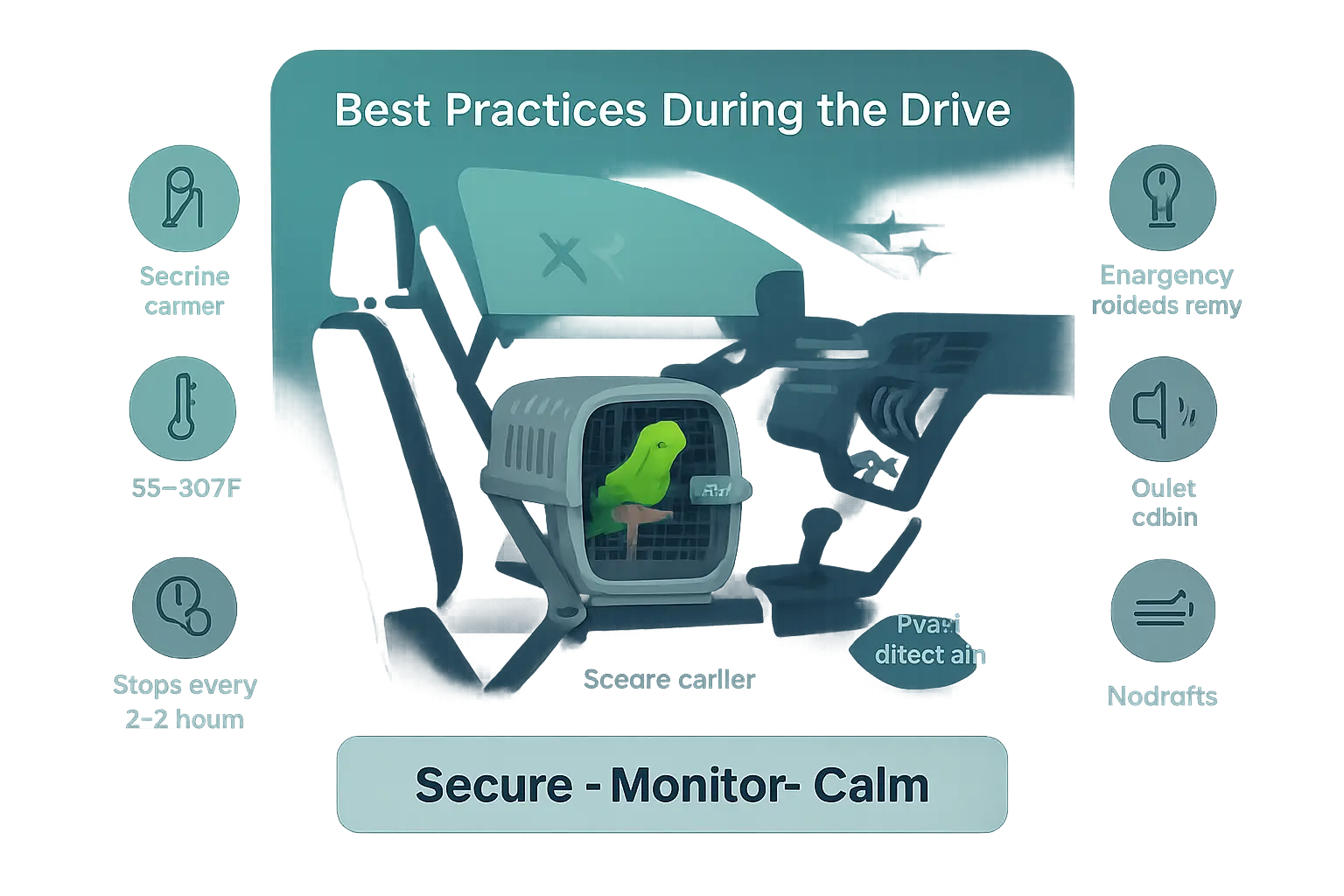
Owners should treat the vehicle like a temporary habitat. Secure the bird in a travel-rated cage or carrier sized for safe movement and ventilation. Position the carrier low and behind the passenger seat to reduce motion sway and sudden shifts. Maintain a stable cabin temperature between 65–80°F and avoid direct sun on the cage. Build a predictable schedule: feed light meals several hours before departure, offer water at stops, and plan breaks every 2–3 hours for a quick visual and vocal check. Pack a dedicated travel kit with clipped wings (if preferred), a towel, syringe for water, comfort perch, first-aid basics, and the bird’s medical records. Keep identification and a recent photo accessible. Owners should also arrange a pre-trip health check with an avian vet and save emergency clinic contacts in the phone. For broader packing and gear recommendations for road travel, review essential dog travel tips and gear for road trips. CTA: Schedule an avian vet exam before long drives.
Securing and monitoring your bird en route (visibility, temperature, behavior checks)
Choose a carrier with solid locks and tie-down points. Use the vehicle’s seatbelt or straps to anchor the carrier firmly. Avoid harnessing a bird loose in the cabin; a secured crate reduces fall and collision risk. Position the carrier so the driver can glance at the bird without turning away. Place a small digital thermometer near the cage to monitor temperature and a lightweight cover to cut glare while preserving airflow. Conduct brief behavior checks every 30–60 minutes during stops: note breathing rate, feather posture, droppings, and food/water intake. If observations change, log the time and symptoms. For tips on fastening carriers safely, see how to secure a cat carrier in car, which covers anchoring techniques applicable to bird carriers.
Minimizing overstimulation: noise, drafts and motion-management tips
Birds react strongly to sensory overload. Reduce noise by keeping windows closed and lowering music. Play calm, consistent background sounds rather than sudden loud tracks. Shield the cage from direct HVAC drafts; direct vents toward the cabin, not the bird. Avoid abrupt maneuvers and maintain steady speeds where possible to reduce vestibular upset. Place the carrier so it moves with the car’s motion—parallel to forward travel—to lessen disorientation. Offer a partial cover to dampen visual stimulation during heavy traffic or busy rest stops. Owners should limit strong-smelling cleaners and scented air fresheners that can irritate avian respiratory systems. For motion-management techniques and ways to calm sensitive travelers, refer to no-more doggie dramas: make car rides enjoyable for motion-sick pups, which includes practical calming strategies transferable to birds.
Immediate steps for distress, injury or unusual behavior
Recognize emergency signs: open-mouth breathing, rapid panting, collapsed posture, bleeding, seizures, sudden blindness, or severe disorientation. At the first sign of distress, pull over safely and move the vehicle to a quiet spot. Keep the bird warm or cool as needed by removing or adding a towel, but avoid shocking temperature changes. Apply gentle pressure with sterile gauze to control bleeding and minimize handling to reduce stress. Place the bird in a dark, quiet carrier and call an avian emergency clinic immediately. Do not administer human medications. If transport to a clinic will take time, phone the vet for step-by-step first-aid guidance while en route. Keep an emergency contact list and a basic first-aid kit in the car. For calming approaches that can help acute anxiety during transport, consult 9 natural ways to remedy travel anxiety.
After the trip: recovery and follow-up care
A calm, predictable environment helps a parrot recover after a car vacation. First remove travel-only items like harnesses and unfamiliar toys. Place the cage where noise and foot traffic stay low. Offer familiar perches, favorite foods, and fresh water on the same schedule used before the trip.
Monitor three daily markers: eating, drinking, and droppings. Note any drop in appetite, looser droppings, or reduced water intake. Weigh the bird daily if possible and log changes. Also watch for feather ruffling, increased sleeping, or unusual vocal patterns.
Limit new experiences for 48–72 hours. Keep enrichment predictable and short to avoid overstimulation. If the parrot shows mild stress signs, use quiet interaction and short training sessions to rebuild confidence.
Owners who want broader tips on travel recovery routines can review general pet road-trip practices like those in essential dog travel tips and gear for road trips. If any concerning signs appear, arrange a vet visit. A timely check prevents minor issues from escalating and supports a safe return to routine.
Helping your parrot recover and re-establish routine
Re-establishing routine starts immediately. Return feeding and sleep times to pre-trip schedules. Feed familiar pellets and fresh foods first, then slowly reintroduce any travel treats.
Rebuild social bonds with short, low-pressure sessions. Offer hand-training or target exercises for five to ten minutes twice daily. Keep tone calm and movements deliberate. Avoid forcing interaction; let the parrot approach.
Reduce environmental stressors. Dim lights during usual rest periods and keep loud music or noisy appliances off. Rotate a few favorite toys instead of presenting many new items at once. Grooming should be gentle and limited to essential care—no full baths after long travel unless the bird shows signs of grime or discomfort.
If the parrot shows signs of anxiety, try strategies used for other travel-stressed pets, such as quiet containment and gradual exposure to normal sounds. For calming techniques that work across species, see how to calm down a cat in the car. Schedule a vet check if stress behaviors persist beyond 72 hours.
When to schedule a post-trip vet check and what records to share
Schedule a vet visit whenever the parrot shows new or worsening signs. Urgent symptoms include labored breathing, severe lethargy, bleeding, dramatic weight loss, or changes in droppings. For mild concerns, arrange a check within 48–72 hours. For international or long-distance travel, plan a routine post-trip exam within 7–14 days.
Bring clear documentation to the appointment. Include vaccination records, any travel permits, a list of current medications and dosages, and the bird’s microchip number if applicable. Also bring a short travel timeline and notes about when symptoms began.
Photographs and short video clips of abnormal behavior, droppings, or breathing patterns help the veterinarian assess the issue more quickly. If the parrot traveled in a carrier, bring notes on how the carrier was secured and positioned; owners can review carrier safety tips like those in how to secure a cat carrier in car before the visit.
Ask the clinic about follow-up monitoring and emergency contacts. If the vet prescribes medication or special care, confirm dosing, storage, and a written care plan. Call to schedule the appointment now if any red-flag signs appear.
Summary
How to Safely Travel by Car on Vacation with Your Parrot confirms that car travel can be safe when health checks, training, and proper equipment lead the plan. With veterinary clearance, a stable, well-ventilated carrier secured correctly, and gradual acclimation to motion and sound, many parrots tolerate thoughtfully paced trips.
Route planning, temperature control (about 65–80°F), and regular stops for hydration and behavior checks keep stress low and issues visible early. Clear go/no-go criteria, a precise packing list, and an emergency playbook—followed by calm post-trip recovery—create a practical, low-risk framework for a bird-centered vacation.
Key Takeaways
- Health and readiness: Obtain vet clearance, assess temperament, and postpone travel for illness, heavy molt, extreme weather, or severe anxiety.
- Secure setup: Use a rigid, well-ventilated carrier with stable perches; anchor it with seatbelts or LATCH behind the front passenger seat or rear center—never in front of an active airbag.
- Train in steps: Build tolerance with short drives (5–10 minutes up to 30–60+), positive reinforcement, and desensitization to car sounds; harness use is for supervised stops only.
- Plan the route: Schedule stops every 1–2 hours for water and checks; maintain 65–80°F, provide shade, and never leave a bird in a parked car.
- Monitor and respond: Watch for eye pinning, panting, fluffed posture, droppings changes, regurgitation, or diarrhea; pull over, reduce stimuli, offer water, and call a vet if signs persist.
- Pack smart: Bring familiar food and water, medications and records, first-aid supplies, ID labels, a thermometer, and backup containment with vet and emergency contacts.
FAQ
- What is the safest way to secure a parrot during car travel?
Anchor a rigid, well-ventilated carrier with a seatbelt or LATCH on the floor behind the front passenger seat or in the rear center. Keep it level, shaded, and away from active airbags.
- How often should a parrot have breaks, and what happens at each stop?
Plan stops every 1–2 hours to offer fresh water, check droppings and breathing, and assess temperature. Provide brief, supervised stretching on a harness only if fully trained.
- What temperature range keeps parrots comfortable in the car?
Maintain roughly 65–80°F (18–27°C), avoid direct sun and drafts, and monitor with a digital thermometer. Never leave a bird unattended in a parked vehicle.
- How can motion sickness be prevented in parrots?
Use gradual acclimation, a forward-facing, stable, low-mounted carrier, and smooth driving; offer only a light snack 1–2 hours before travel. Consult an avian vet before using any medication.
- Why should a parrot sometimes stay home instead of traveling?
Illness, recent medication or surgery, heavy molt or injury, extreme weather, and untrained or highly anxious behavior raise risk beyond benefit. Opt for boarding or a trusted sitter in these cases.

